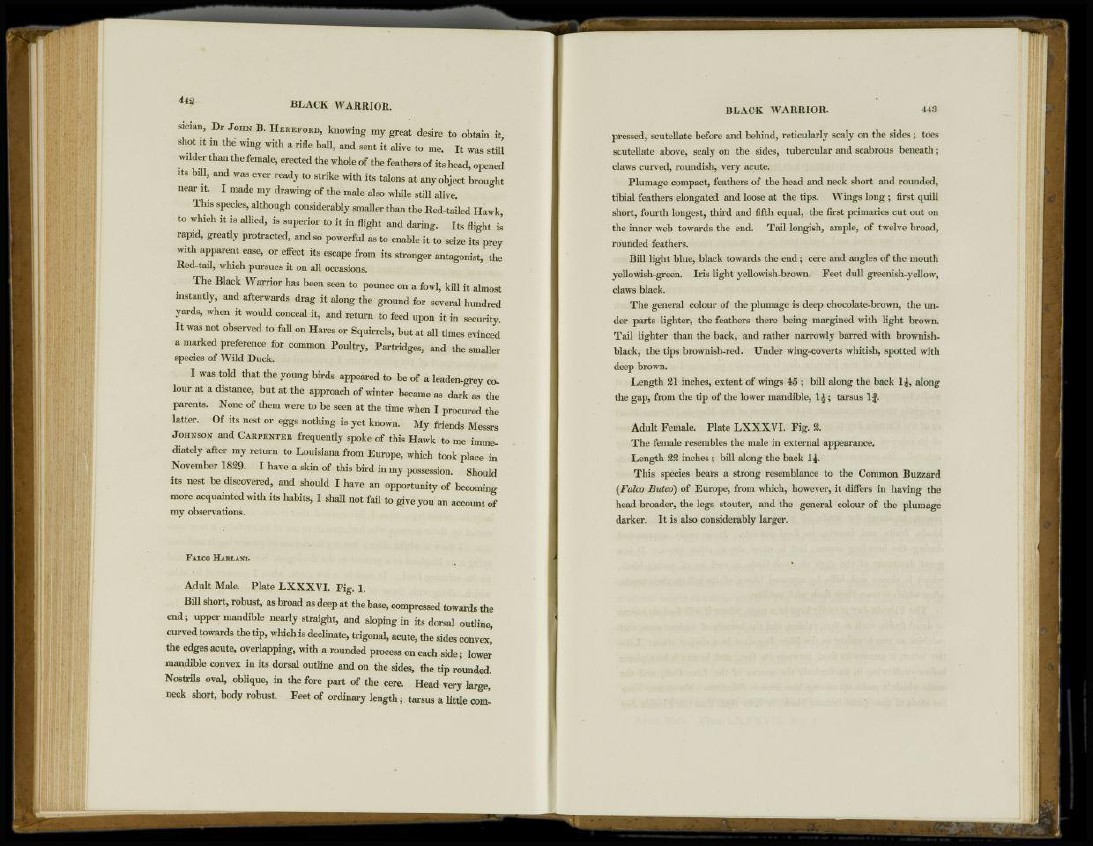
442 BLACK WARRIOR.
sician, Dr JOHN B. HEREFORD, knowing my great desire to obtain it,
shot it in the wing with a rifle ball, and sent it alive to me. It was still
wilder than the female, erected the whole of the feathers of its head, opened
its bill, and was ever ready to strike with its talons at any object brought
near it. I made my drawing of the male also while still alive.
This species, although considerably smaller than the Red-tailed Hawk,
to which it is allied, is superior to it in flight and daring. Its flight is
rapid, greatly protracted, and so powerful as to enable it to seize its prey
with apparent ease, or effect its escape from its stronger antagonist, the
Red-tail, which pursues it on all occasions.
The Black Warrior has been seen to pounce on a fowl, kill it almost
instantly, and afterwards drag it along the ground for several hundred
yards, when it would conceal it, and return to feed upon it in security.
It was not observed to fall on Hares or Squirrels, but at all times evinced
a marked preference for common Poultry, Partridges, and the smaller
species of Wild Duck.
I was told that the young birds appeared to be of a leaden-grey colour
at a distance, but at the approach of winter became as dark as the
parents. None of them were to be seen at the time when I procured the
latter. Of its nest or eggs nothing is yet known. My friends Messrs
JOHNSON and CARPENTER frequently spoke of this Hawk to me immediately
after my return to Louisiana from Europe, which took place in
November 1829- I have a skin of this bird in my possession. Should
its nest be discovered, and should I have an opportunity of becoming
more acquainted with its habits, I shall not fail to give you an account of
my observations.
FALCO HARLANI.
Adult Male. Plate LXXXVI. Fig. 1.
Bill short, robust, as broad as deep at the base, compressed towards the
end; upper mandible nearly straight, and sloping in its dorsal outline,
curved towards the tip, which is declinate, trigonal, acute, the sides convex,
the edges acute, overlapping, with a rounded process on each side; lower
mandible convex in its dorsal outline and on the sides, the tip rounded.
Nostrils oval, oblique, in the fore part of the cere. Head very large,
neck short, body robust. Feet of ordinary length; tarsus a little com-
BLACK WARRIOR. 443
pressed, scutellate before and behind, reticularly scaly on the sides ; toes
scutellate above, scaly on the sides, tubercular and scabrous beneath;
claws curved, roundish, very acute.
Plumage compact, feathers of the head and neck short and rounded,
tibial feathers elongated and loose at the tips. Wings long ; first quill
short, fourth longest, third and fifth equal, the first primaries cut out on
the inner web towards the end. Tail longish, ample, of twelve broad,
rounded feathers.
Bill fight blue, black towards the end; cere and angles of the mouth
yellowish-green. Iris fight yellowish-brown. Feet dull greenish-yellow,
claws black.
The general colour of the plumage is deep chocolate-brown, the under
parts fighter, the feathers there being margined with light brown.
Tail fighter than the back, and rather narrowly barred with brownishblack,
the tips brownish-red. Under wing-coverts whitish, spotted with
deep brown.
Length 21 inches, extent of wings 45 ; bill along the back 1£, along
the gap, from the tip of the lower mandible, 1£; tarsus If.
Adult Female. Plate LXXXVI. Fig. %
The female resembles the male in external appearance.
Length 22 inches; bill along the back 1£.
This species bears a strong resemblance to the Common Buzzard
{Falco Bated) of Europe, from which, however, it differs in having the
head broader, the legs stouter, and the general colour of the plumage
darker. It is also considerably larger.